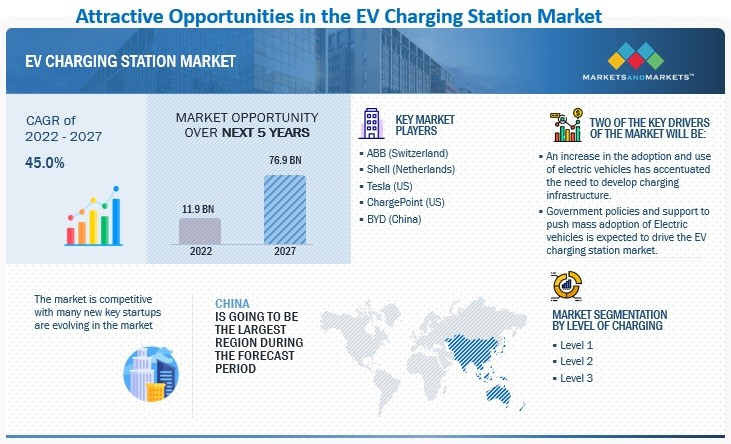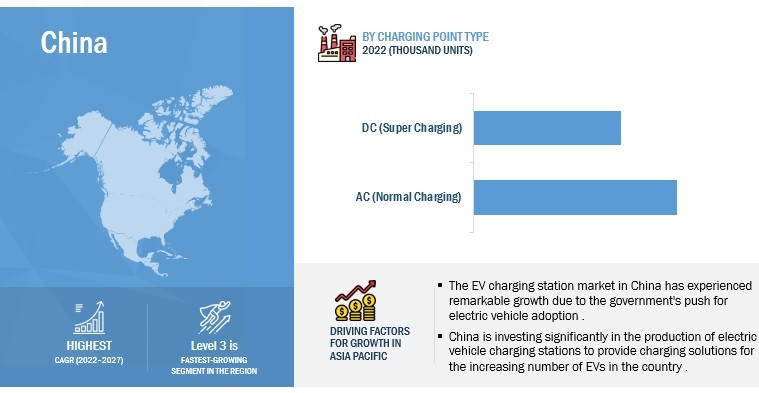EV Charging Station Market,Installation and Region - Global Forecast to 2027
EV Charging Station Market Dynamics:
Driver: Increase in EV sales Worldwide

The surge in adoption and use of electric vehicles has highlighted the need to develop charging infrastructure. Top markets for EVs, including China.
US and Germany. Significant investment has been made in EV charging infrastructure and R&D to find faster and more efficient charging methods.
As EV adoption continues to rise, the need for charging infrastructure is expected to grow exponentially, especially in regions with high concentrations of EV owners.
This has spurred investment by governments, businesses and other organizations in deploying additional public charging stations to meet the needs of EV owners.
Most EV owners have also installed their own home charging stations, further stimulating demand for charging infrastructure. In 2022, global electric vehicle sales will increase significantly, accounting for more than 10% of total vehicle sales.
China is the largest market for electric vehicle sales, followed by Europe and the United States.
Electric vehicles are becoming more popular as people seek to reduce their carbon footprint and lower transportation costs.
However, one of the major challenges facing EV adoption is the availability of charging infrastructure.
Smart cities can help overcome this challenge by making it easier for drivers to locate and use by deploying a network of charging stations connected to a centralized system.
Smart city infrastructure can also support the growth of the FV charging station market by providing a platform for new business models.
For example, companies could leverage data generated by smart city infrastructure to offer innovative services such as dynamic pricing booking systems and provide personalized advice to electric vehicle drivers.
Based on operations, mode 3 is expected to hold a larger market share during the forecast period
Mode 3 EV charging stations are becoming more popular as the demand for EVs grows. These charging stations are equipped with a Type 2 socket to provide AC charging for the vehicle. They can be installed in public places, workplaces and apartment complexes Mode 3 Not for private use. Mode 3 is a type of EV charging commonly found at public charging stations. This charging mode involves a Level 2 AC charger, which provides higher charging power than a standard household outlet.
Recent developments in Mode 3 EV charging include the introduction of faster charging rates, improved safety features and a more user-friendly interface. Many countries are investing heavily in Mode 3 charging infrastructure to support the growth of the EV market. In Europe, Oppen has set a goal of installing 100,000 public charging points by 2025, and in the US, major automakers and utilities have partnered to build TEPCO's network. Several states have set goals for EV adoption and charging infrastructure deployment.
China will be the largest market by volume during the forecast period
China is expected to account for the largest market share by 2027, followed by Europe and Asia Pacific. The market for electric vehicle charging stations in China has experienced significant growth owing to the government's strong promotion of electric vehicles. This has led to a surge in demand for charging infrastructure, leading to China's largest network of more than 1.8 million charging points, controlled by leading players such as State Grid. China Southern Power Grid, and Star Charging. The government aims to deploy 4.8 million charging points by 2025. Enforcing EV charging infrastructure requirements in new buildings
China has stopped providing subsidies to EV buyers by January 2023, but other measures are expected to keep the industry's momentum going. The subsidy was originally intended to compensate for the price difference between electric vehicles and internal combustion engine vehicles and promote commercialization. Experts believe the EV market will continue to expand as consumer interest increases and auto companies invest in EV development. The government's green car credit system is designed to encourage the production of electric vehicles. Some experts have suggested that banning the sale of internal combustion engine vehicles could be another strong policy, and some local governments are already considering the move











